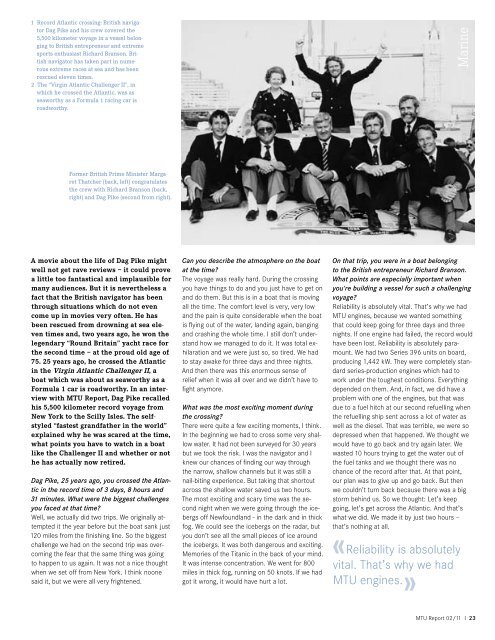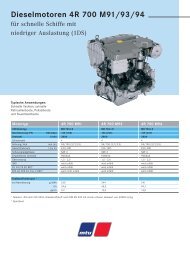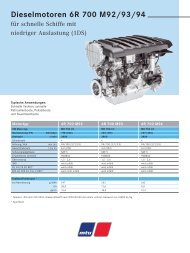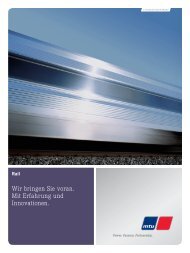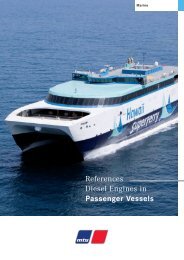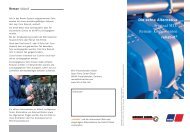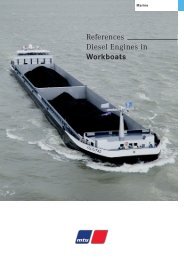Create successful ePaper yourself
Turn your PDF publications into a flip-book with our unique Google optimized e-Paper software.
1 Record Atlantic crossing: British navigator<br />
Dag Pike and his crew covered the<br />
5,500 kilometer voyage in a vessel belonging<br />
to British entrepreneur and extreme<br />
sports enthusiast Richard Branson. British<br />
navigator has taken part in numerous<br />
extreme races at sea and has been<br />
rescued eleven times.<br />
2 The “Virgin Atlantic Challenger II”, in<br />
which he crossed the Atlantic, was as<br />
seaworthy as a Formula 1 racing car is<br />
roadworthy.<br />
Former British Prime Minister Margaret<br />
Thatcher (back, left) congratulates<br />
the crew with Richard Branson (back,<br />
right) and Dag Pike (second from right).<br />
A movie about the life <strong>of</strong> Dag Pike might<br />
well not get rave reviews – it could prove<br />
a little too fantastical and implausible for<br />
many audiences. But it is nevertheless a<br />
fact that the British navigator has been<br />
through situations which do not even<br />
come up in movies very <strong>of</strong>ten. He has<br />
been rescued from drowning at sea eleven<br />
times and, two years ago, he won the<br />
legendary “Round Britain” yacht race for<br />
the second time – at the proud old age <strong>of</strong><br />
75. 25 years ago, he crossed the Atlantic<br />
in the Virgin Atlantic Challenger II, a<br />
boat which was about as seaworthy as a<br />
Formula 1 car is roadworthy. In an interview<br />
with <strong>MTU</strong> Report, Dag Pike recalled<br />
his 5,500 kilometer record voyage from<br />
New York to the Scilly Isles. The selfstyled<br />
“fastest grandfather in the world”<br />
explained why he was scared at the time,<br />
what points you have to watch in a boat<br />
like the Challenger II and whether or not<br />
he has actually now retired.<br />
Dag Pike, 25 years ago, you crossed the Atlantic<br />
in the record time <strong>of</strong> 3 days, 8 hours and<br />
31 minutes. What were the biggest challenges<br />
you faced at that time?<br />
Well, we actually did two trips. We originally attempted<br />
it the year before but the boat sank just<br />
120 miles from the finishing line. So the biggest<br />
challenge we had on the second trip was overcoming<br />
the fear that the same thing was going<br />
to happen to us again. It was not a nice thought<br />
when we set <strong>of</strong>f from New York. I think noone<br />
said it, but we were all very frightened.<br />
Can you describe the atmosphere on the boat<br />
at the time?<br />
The voyage was really hard. During the crossing<br />
you have things to do and you just have to get on<br />
and do them. But this is in a boat that is moving<br />
all the time. The comfort level is very, very low<br />
and the pain is quite considerable when the boat<br />
is flying out <strong>of</strong> the water, landing again, banging<br />
and crashing the whole time. I still don’t understand<br />
how we managed to do it. It was total exhilaration<br />
and we were just so, so tired. We had<br />
to stay awake for three days and three nights.<br />
And then there was this enormous sense <strong>of</strong><br />
relief when it was all over and we didn’t have to<br />
fight anymore.<br />
What was the most exciting moment during<br />
the crossing?<br />
There were quite a few exciting moments, I think.<br />
In the beginning we had to cross some very shallow<br />
water. It had not been surveyed for 30 years<br />
but we took the risk. I was the navigator and I<br />
knew our chances <strong>of</strong> finding our way through<br />
the narrow, shallow channels but it was still a<br />
nail-biting experience. But taking that shortcut<br />
across the shallow water saved us two hours.<br />
The most exciting and scary time was the second<br />
night when we were going through the icebergs<br />
<strong>of</strong>f Newfoundland - in the dark and in thick<br />
fog. We could see the icebergs on the radar, but<br />
you don’t see all the small pieces <strong>of</strong> ice around<br />
the icebergs. It was both dangerous and exciting.<br />
Memories <strong>of</strong> the Titanic in the back <strong>of</strong> your mind.<br />
It was intense concentration. We went for 800<br />
miles in thick fog, running on 50 knots. If we had<br />
got it wrong, it would have hurt a lot.<br />
Marine<br />
On that trip, you were in a boat belonging<br />
to the British entrepreneur Richard Branson.<br />
What points are especially important when<br />
you‘re building a vessel for such a challenging<br />
voyage?<br />
Reliability is absolutely vital. That’s why we had<br />
<strong>MTU</strong> engines, because we wanted something<br />
that could keep going for three days and three<br />
nights. If one engine had failed, the record would<br />
have been lost. Reliability is absolutely paramount.<br />
We had two Series 396 units on board,<br />
producing 1,442 kW. They were completely standard<br />
series-production engines which had to<br />
work under the toughest conditions. Everything<br />
depended on them. And, in fact, we did have a<br />
problem with one <strong>of</strong> the engines, but that was<br />
due to a fuel hitch at our second refuelling when<br />
the refuelling ship sent across a lot <strong>of</strong> water as<br />
well as the diesel. That was terrible, we were so<br />
depressed when that happened. We thought we<br />
would have to go back and try again later. We<br />
wasted 10 hours trying to get the water out <strong>of</strong><br />
the fuel tanks and we thought there was no<br />
chance <strong>of</strong> the record after that. At that point,<br />
our plan was to give up and go back. But then<br />
we couldn’t turn back because there was a big<br />
storm behind us. So we thought: Let’s keep<br />
going, let’s get across the Atlantic. And that’s<br />
what we did. We made it by just two hours –<br />
that’s nothing at all.<br />
«Reliability is absolutely<br />
vital. That’s why we had<br />
<strong>MTU</strong> engines.»<br />
<strong>MTU</strong> Report 02/11 I 23


